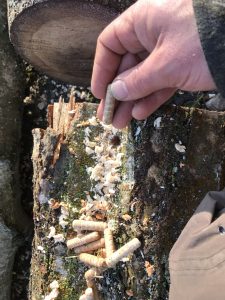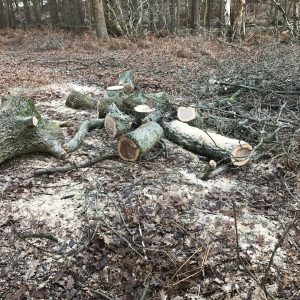Growing Mushrooms on Logs in your Woodland.

It wasn’t until I started spending more time in our woodland that the thought of foraging entered my mind. Over the seasons the landscape revealed both edible delights and seasonal beauty: I hadn’t realised how prized the bilberries were to the wildlife and how little chance I had to add them to my breakfast bowl or to pancakes made on an open fire.
We are lucky enough to have a semi ancient woodland but its overplanting warranted some thinning of the spindly oaks. It pained me to take down my first tree but I saw it as a symbiotic relationship where the intervention was aiding the long-term wellbeing of the woodland. Thinking about this threw up the idea of growing edible mushrooms.
A little research when I returned home soon equipped me with enough knowledge to confidently try my hand at inoculating fallen oak. My reading revealed that oak was the perfect wood to attempt this on, and Iooked forward to tucking into a meaty mushroom one evening or a mushroom omelette in the morning.
I was sold. I ordered myself a few packs of mushroom spores which came looking like furry wooden dowels in packs. I selected chicken of the woods, shitake, tarragon oysters, reishi and summer oyster, all of which enjoy being cultivated on oak.
 The idea is to use wood that has been recently felled, not much more than a month on the floor and has probably been colonised by other mycelium. You need lengths stripped of their branches and of about one metre. When getting to the inoculating you need a wooden drill bit…the black one…8mm or 10mm, a hand drill with as many charged batteries as you have….I was fast to find out how much energy is required to drill into oak…and you need a method to label your logs if using more than one species of mushroom.
The idea is to use wood that has been recently felled, not much more than a month on the floor and has probably been colonised by other mycelium. You need lengths stripped of their branches and of about one metre. When getting to the inoculating you need a wooden drill bit…the black one…8mm or 10mm, a hand drill with as many charged batteries as you have….I was fast to find out how much energy is required to drill into oak…and you need a method to label your logs if using more than one species of mushroom.
I drilled the holes in my logs in a diamond pattern for even distribution using about 60 plugs per meter length (don’t worry about the cost - they are cheaper than you think to purchase). I inserted the small plugs into the holes, got my young children to label the ends of the logs and stored them in groups by species.
The host logs need to have moisture for the mushroom run to start. While there are varying techniques on achieving this dampness, I decided to rely more on the natural forces. Knowing full well the rainfall and damp nature of the place where I was placing the logs, as well as the fact I was performing the inoculation during the wetter months, I used a basic stacking technique. Here the first two logs are placed down about 70cm apart, the next two stacked upon them in the opposite direction and continuing to about three logs high, leaving things as rough and haphazard as I could get away with. Now it’s a waiting game until temperatures get up to 15 degrees and above. As long as the logs don’t dry out, I’m confident of a generous yield.
Comments are closed for this post.
Discussion
What do you think about grwoing gourmet species like Chanterelle and Porcini in Woodland? I found this shop: https://www.wildfoodie.co.uk/grow-your-own-wild-mushrooms, they sell both Porcini and Chanterelle.. Anyone ever tried it?
How did it go?
How long are the plugs (so as to gauge depth of drilling)?
There’s a few suppliers online, I’ve used http://mushroombox.co.uk/ recently (seems fine but it’s too early to say, first harvest of mushrooms not expected for a while yet)
Where do you get plugs please BB
Good stuff using wood intelligently when not used for logs. I am wondering how long until a harvest of shrooms is expected.
Have done this myself recently with oysters. Looking forward to seeing results

Hey that’s really good. I’m going to consider doing this too as I’ve been inspired thanks to your post!
I also got the idea when I visit https://www.waleswoodland.co.uk and they had a similar setup there too and you are right the guy mentioned using fallen trees that just fell as they have lots of water in them which is good for the spores when planting mushrooms.
Richard Walters
16 November, 2022